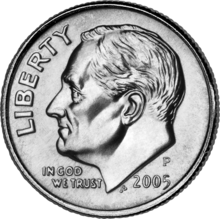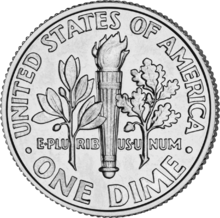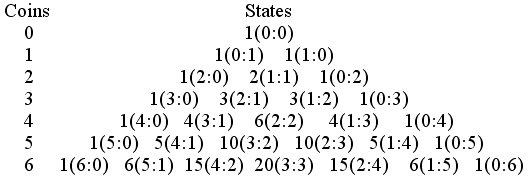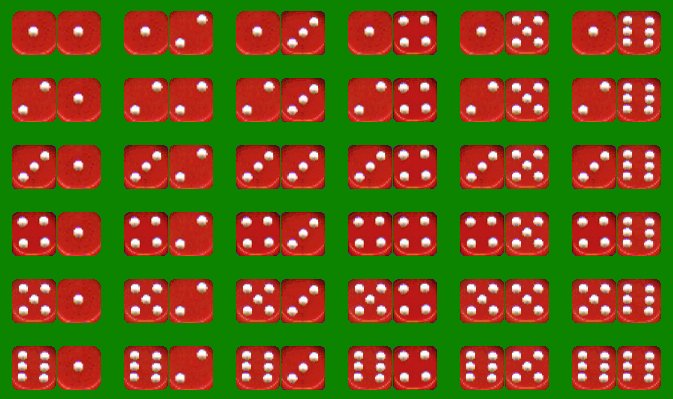|
Nature abhors a vacuum, but but loves disorder...
On a previous page I played around with the probability that life on earth arose spontaneously by chance encounters among the atoms that make up living organisms. This page is in support of my examination of the probability that just by chance the universe itself might take the form in which we find it. In particular the story involves microstates, macrostates and probability but the story begins simply enough with the toss of a coin.
Imagine that we have a coin with two distinct sides as shown below.
  The side with the image of a head is called "heads", the other side is called "tails". The coin, when tossed onto a flat, hard, horizontal surface, will settle down to one of two equally probable states - heads or tails. I will identify these two states as (0:1) - 0 heads and 1 tails, and (1:0) - 1 head and zero tails. The sum of all probabilities must be 1 so the probability of a head or a tail is 0.5. For those readers who are pervertedly pedantic, yes, there is a slight probability of a coin landing on edge but its probability is so small compared to 0.5 that we should neglect it in favor of keeping things simple.
The side with the image of a head is called "heads", the other side is called "tails". The coin, when tossed onto a flat, hard, horizontal surface, will settle down to one of two equally probable states - heads or tails. I will identify these two states as (0:1) - 0 heads and 1 tails, and (1:0) - 1 head and zero tails. The sum of all probabilities must be 1 so the probability of a head or a tail is 0.5. For those readers who are pervertedly pedantic, yes, there is a slight probability of a coin landing on edge but its probability is so small compared to 0.5 that we should neglect it in favor of keeping things simple.
Now let's toss two coins, coin 1 and 2, together. What are the possible states of this two-coin system after the toss? We might get coin 1 and 2 both tails, coin 1 heads and coin 2 tails, coin 1 tails and coin 2 heads, or coin 1 and 2 both heads. The possible states then are (0:2), (1:1), another (1:1) and (2:0). Since the coins are identical, we cannot tell the difference between the two (1:1) states so we can designate the set of states as (0:2), 2(1:1), (2:0) for a total of 4 equally probable states. We call each of these equally probable states a microstate of the system of tossed coins. Of the four microstates in this example, only three are physically distinct from one another. We call the physically distinct states macrostates of the system. The macrostates are (0:2), (1:1) and (2:0). Notice that the macrostates are not all equally probable. In tossing two coins many times, you will find that the mixed macrostate (1:1) will occur about twice as often as either of the pure macrostates, (0:2) or (2:0), because the mixed macrostate contains two microstates to their one.
It turns out that there is a neat mathematical trick for calculating the number of microstates in systems like this where each element of the system (here a coin) has only two possible states. The trick, illustrated below for a system of 6 tossed coins, is called Pascal's triangle. Notice we begin the triangle at the top with the case where no coins at all are tossed, yielding a single microstate of no heads and no tails.
 Each row in the triangle lists the macrostates, (0:2), (1:1), (2:0) for example, each preceded by the number of microstates in that macrostate as in 1(0:2) 2(1:1) 1(2:0). To find the number of microstates in each macrostate of a row, add up the number of microstates that appear in the row above, immediately to the right and left of the macrostate of interest. With sufficient patience you can verify that for a toss of six coins there are 20 ways to get the (3:3) perfectly mixed macrostate, 15 ways to get the (2:4) or (4:2) moderately mixed macrostate and 6 ways to get the (1:5) or (5:1) slightly mixed macrostates. The perfectly pure macrostates (0:6) or (6:0) only contain a single microstate. The probability of the occurrence of any particular macrostate is simply the number of microstates in that macrostate divided by the total number of microstates available to the system. That total number of possible microstates for the six coin system is 64, which may be arrived at by adding up the number of microstates in each of the row's macrostates.
Each row in the triangle lists the macrostates, (0:2), (1:1), (2:0) for example, each preceded by the number of microstates in that macrostate as in 1(0:2) 2(1:1) 1(2:0). To find the number of microstates in each macrostate of a row, add up the number of microstates that appear in the row above, immediately to the right and left of the macrostate of interest. With sufficient patience you can verify that for a toss of six coins there are 20 ways to get the (3:3) perfectly mixed macrostate, 15 ways to get the (2:4) or (4:2) moderately mixed macrostate and 6 ways to get the (1:5) or (5:1) slightly mixed macrostates. The perfectly pure macrostates (0:6) or (6:0) only contain a single microstate. The probability of the occurrence of any particular macrostate is simply the number of microstates in that macrostate divided by the total number of microstates available to the system. That total number of possible microstates for the six coin system is 64, which may be arrived at by adding up the number of microstates in each of the row's macrostates.
What this coin tossing exercise showed us is that blind chance favors the occurrence of mixed macrostates over pure macrostates by an amount that goes up extremely rapidly as the number of components in a system increases. For two coins the probability of either pure state is 0.25=1/4, for six coins it is 1/64, for 12 coins it is 1/4096, for n coins it is 1/2n where 2n is 2 multiplied by itself n times. The more mixed the macrostate, the more probable it occurrence, with the bulk of the available microstates concentrated near the center of each row in Pascal's triangle.
Enough of the coins for now. Next consider the toss of some dice.
 Each die (as opposed to douse, which one might expect by analogy to the mice/mouse situation) has six sides identified by dots as side 1 through 6. If the die is properly constructed each side has the same probability of ending up on top after a toss of the die. Since the probability of the six outcomes must add to 1, each outcome of a toss has a probability of 1/6.
Each die (as opposed to douse, which one might expect by analogy to the mice/mouse situation) has six sides identified by dots as side 1 through 6. If the die is properly constructed each side has the same probability of ending up on top after a toss of the die. Since the probability of the six outcomes must add to 1, each outcome of a toss has a probability of 1/6.
Now consider tossing two dice at once. The possible outcomes are shown below.
 The possible microstates for a two-dice system are laid out in a symmetrical 6X6 array for ease of counting. There are 36 total microstates = 62.
There are 6 pure macrostates lying along the top-left to bottom-right diagonal of the array of microstates. The remaining 30 microstates lie off the diagonal and occur in pairs. Since we cannot tell the dice apart, each off diagonal symmetrical pair of microstates constitute only a single macrostate. There are then 15 mixed macrostates for a total of 21.
The possible microstates for a two-dice system are laid out in a symmetrical 6X6 array for ease of counting. There are 36 total microstates = 62.
There are 6 pure macrostates lying along the top-left to bottom-right diagonal of the array of microstates. The remaining 30 microstates lie off the diagonal and occur in pairs. Since we cannot tell the dice apart, each off diagonal symmetrical pair of microstates constitute only a single macrostate. There are then 15 mixed macrostates for a total of 21.
Clearly introducing six-outcome objects complicated the picture. The chance of getting a particular pure macrostate for a system of two tossed dice is 1/62. For a system of n tossed dice it is 1/6n. For a system of 6 tossed dice there are 46,656 microstates distributed among 462 distinct macrostates, again with the more mixed macrostates getting the bulk of the possible microstates. It is a result of the arithmetic of chance that all the systems in nature, however complex the system and however complex the process they undergo, are very likely to be found in a severely mixed (or disorderly) macrostate after the process even if the initial condition was highly ordered.
|




